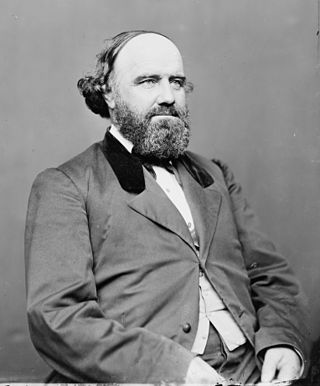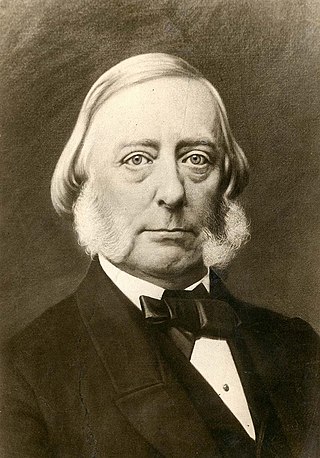Related Research Articles

The 1856 United States presidential election was the 18th quadrennial presidential election, held on Tuesday, November 4, 1856. In a threeway election, Democrat James Buchanan defeated Republican nominee John C. Frémont and Know Nothing/Whig nominee Millard Fillmore. The main issue was the expansion of slavery as facilitated by the Kansas–Nebraska Act of 1854. Buchanan defeated President Franklin Pierce at the 1856 Democratic National Convention for the nomination. Pierce had become widely unpopular in the North because of his support for the pro-slavery faction in the ongoing civil war in territorial Kansas, and Buchanan, a former Secretary of State, had avoided the divisive debates over the Kansas–Nebraska Act by being in Europe as the Ambassador to the United Kingdom.

John Brown was an American evangelist who was a prominent leader in the American abolitionist movement in the decades preceding the Civil War. First reaching national prominence in the 1850s for his radical abolitionism and fighting in Bleeding Kansas, Brown was captured, tried, and executed by the Commonwealth of Virginia for a raid and incitement of a slave rebellion at Harpers Ferry in 1859.

John White Geary was an American lawyer, politician, Freemason, and a Union general in the American Civil War. He was the final alcalde and first mayor of San Francisco, a governor of the Kansas Territory, and the 16th governor of Pennsylvania.

Bleeding Kansas, Bloody Kansas, or the Border War, was a series of violent civil confrontations in Kansas Territory, and to a lesser extent in western Missouri, between 1854 and 1859. It emerged from a political and ideological debate over the legality of slavery in the proposed state of Kansas.

The sacking of Lawrence occurred on May 21, 1856, when pro-slavery settlers, led by Douglas County Sheriff Samuel J. Jones, attacked and ransacked Lawrence, Kansas, a town that had been founded by anti-slavery settlers from Massachusetts who were hoping to make Kansas a free state. The incident fueled the irregular conflict in Kansas Territory that later became known as Bleeding Kansas.

Colonel Cyrus Kurtz Holliday was an American railroad executive who was one of the founders of the township of Topeka, Kansas, in the mid 19th century; and was Adjutant General of Kansas during the American Civil War. The title Colonel, however, was honorary. He was the first president of the Atchison, Topeka and Santa Fe Railway, as well as one of the railroad's directors for nearly 40 years, up to 1900. A number of railway locomotives have been named after him, as well as the former town of Holliday, Kansas. He was also the Deputy Grand Master of the Grand Lodge A.F. & A.M. of Kansas. As a Freemason, he was a member of Topeka Lodge #17 and was highly influential in the decision of moving the State Capitol to the city of Topeka.

Samuel Clarke Pomeroy was a United States senator from Kansas in the mid-19th century. He served in the United States Senate during the American Civil War. Pomeroy also served in the Massachusetts House of Representatives. A Republican, he also was the mayor of Atchison, Kansas, from 1858 to 1859, the second president of the Atchison, Topeka and Santa Fe Railroad, and the first president to oversee any of the railroad's construction and operations. Pomeroy succeeded Cyrus K. Holliday as president of the railroad on January 13, 1864.

Martin Franklin Conway was a U.S. congressman, consul to France, abolitionist, and advocate of the Free-State movement in Kansas.

Andrew Horatio Reeder was the first governor of the Territory of Kansas.

Benjamin Franklin Stringfellow was a pro-slavery border ruffian in Kansas, when the slavery issue was put to a local vote in 1855 under the Popular Sovereignty provision.
1856 in the United States included some significant events that pushed the nation closer towards civil war.

Thomas Gaddis (1742–1834) was a militia officer in the American Revolutionary War. He was born December 28, 1742, in Winchester, Frederick County, Virginia and married Hannah Rice in 1764; the same year he built Fort Gaddis, a refuge from the Indians, located on the Catawba Trail. In fact, Pennsylvania and Virginia had conflicting claims in the area Gaddis settled. Though he maintained his loyalty to Virginia, Gaddis also protected his investment by recording his patent with Pennsylvania authorities. By 1773, both states created new geo-political boundaries in recognition of increased white settlement. Pennsylvania formed Westmoreland County out of the larger Bedford County, and Virginia established the District of West Augusta. In 1776, West Augusta was further divided into three counties: Ohio, Yohogania, and Monongalia, where Gaddis and his family resided.

John Hopwood was an American civil servant during the American Revolutionary War and founded the town of Hopwood, Pennsylvania in western Pennsylvania. John Hopwood was born in Virginia and married Hannah Bearcroft/Barecroft Humphreys, the young widow of Joseph Humphries, in 1770.
The following list is a Bibliography of American Civil War Union military unit histories. More details on each book are available at WorldCat.

The caning of Charles Sumner, or the Brooks–Sumner Affair, occurred on May 22, 1856, in the United States Senate chamber, when Representative Preston Brooks, a pro-slavery Democrat from South Carolina, used a walking cane to attack Senator Charles Sumner, an abolitionist Republican from Massachusetts. The attack was in retaliation for an invective-laden speech given by Sumner two days earlier in which he fiercely criticized slaveholders, including pro-slavery South Carolina Senator Andrew Butler, a relative of Brooks. The beating nearly killed Sumner and contributed significantly to the country's polarization over the issue of slavery. It has been considered symbolic of the "breakdown of reasoned discourse" and willingness to resort to violence that eventually led to the Civil War.

Samuel J. Reader (1836–1914) was an American diarist and artist who wrote about his experiences living in Bleeding Kansas and the American Civil War.

Indianola, also known as Indianola townsite, was a settlement in Shawnee County, Kansas north of Topeka. It was established in 1854 along the government and stage road between Fort Riley and Fort Leavenworth, and received more visitors than the nearby town of Topeka. At the time, the area was part of the Kansas Territory. Samuel J. Reader settled in the area in 1855 and established a farm at the age of 19. He stayed in the area and kept a diary about local events, including Bleeding Kansas, Civil War events, and area skirmishes.

Franklin Guest Smith was a career officer in the United States Army. A Union Army veteran of the American Civil War, Smith also served in the American Indian Wars and the Spanish–American War, and attained the rank of brigadier general.
References
- ↑ "Journal". 15 May 2018. Retrieved 15 May 2018– via Google Books.
- ↑ Shepherd, Henry Elliot (15 May 2018). "Nelson's Biographical Dictionary and Historical Reference Book of Fayette County, Pennsylvania: Containing a Condensed History of Pennsylvania, of Fayette County, and the Boroughs and Townships of the County : Also, Portraits and Biographies of the Governors Since 1790, and Genealogies, Family Histories and Biographies of Representative Men of the County : Illustrated". S.B. Nelson. Retrieved 15 May 2018– via Google Books.
- ↑ "Territorial Kansas Online - Browse by Keyword". www2.ku.edu. Retrieved 15 May 2018.
- 1 2 Smith, Adam I. P. (6 October 2017). The Stormy Present: Conservatism and the Problem of Slavery in Northern Politics, 1846–1865. UNC Press Books. ISBN 9781469633909 . Retrieved 15 May 2018– via Google Books.
- ↑ "William Y. Roberts and Samuel Clarke Pomeroy to Cyrus Kurtz Holliday - Kansas Memory - Kansas Historical Society". www.kshs.org. Retrieved 15 May 2018.
- ↑ Blackmar, Frank Wilson (1912). Kansas: A Cyclopedia of State History, Embracing Events, Institutions, Industries, Counties, Cities, Towns, Prominent Persons, Etc. ... With a Supplementary Volume Devoted to Selected Personal History and Reminiscence. Standard Publishing Company. ISBN 9780722249055.
- ↑ Armitage, Katie H. (15 May 2018). Lawrence: Survivors of Quantrill's Raid. Arcadia Publishing. ISBN 9780738577999 . Retrieved 15 May 2018– via Google Books.